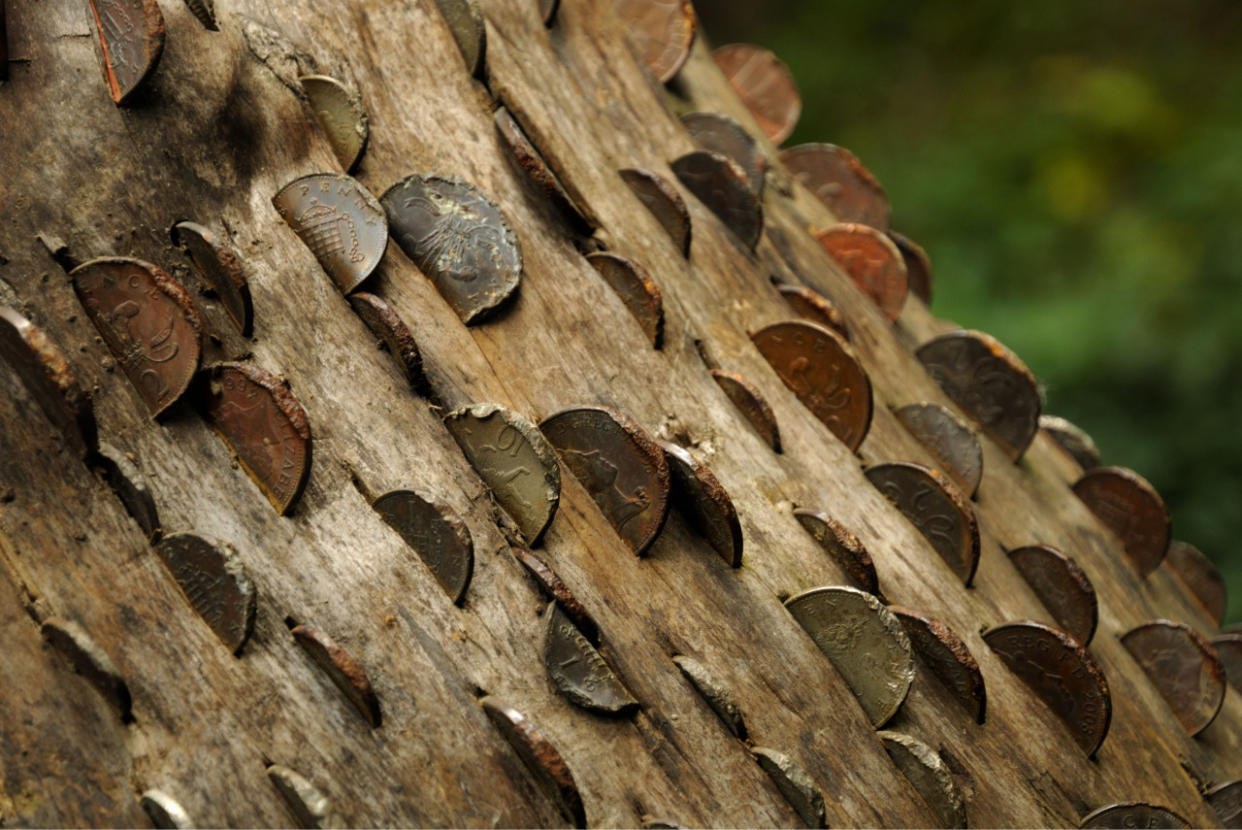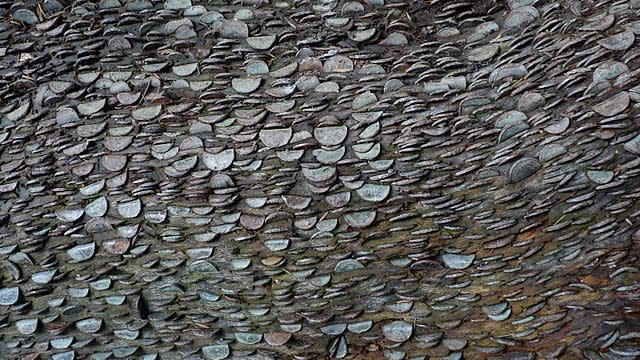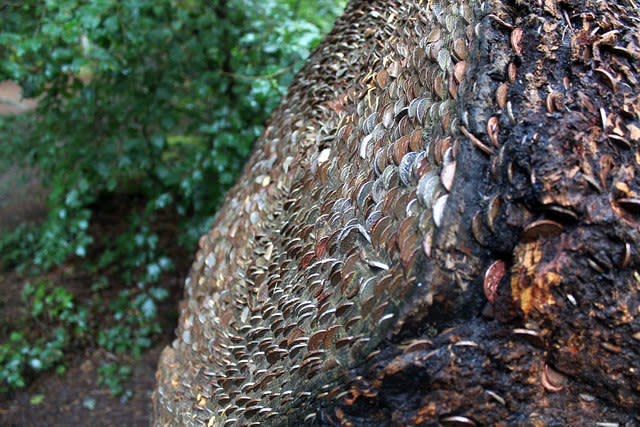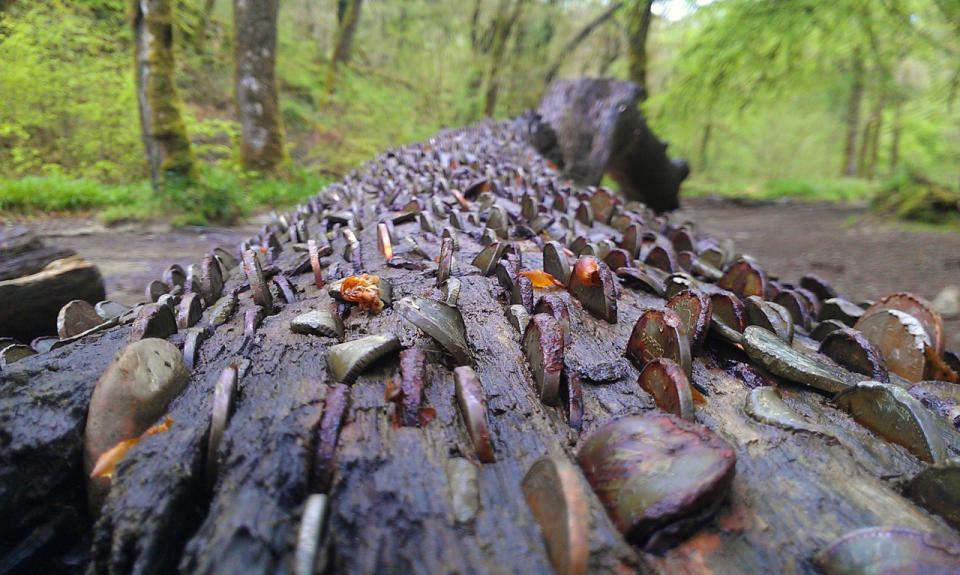The story behind Britain’s mysterious coin trees

In 2011, a series of mysterious trees were spotted around the Welsh seaside town of Portmeirion – each with hundreds of coins pressed into their bark.
Staff at Sir Clough Williams-Ellis’s beautiful Italianate village found the money, mostly 2ps, impossible to remove.
Meurig Jones, the estate manager at the attraction, said: “The first three trees have probably got a thousand coins in. It’s not any particular type of tree either.
“It’s beech, holly and some of the stumps are quite hard so it takes some time for people to knock the coins in,” he said.
“We haven’t publicised it at all, none of the trees have been cut down deliberately, it’s just happened, it’s quite amazing really,” he added.
Although the pictures of the felled trees made national news, the strange phenomenon is not confined to the Welsh town.

Aira Force, Ullswater, Cumbria (Rosser1954)
In fact, the these coin-studded trees can be found across the UK, particularly in the Lake District and Yorkshire.
But their story dates much further back this recent attention may suggest.
“I did some detective work,” Jones told the BBC, “and discovered that trees were sometimes used as ‘wishing trees’.
“In Britain it dates back to the 1700s — there is one tree in Scotland somewhere which apparently has a florin [an old gold coin] stuck into it.”
The tradition, which probably has pagan roots, was believed to bring about good health.
People believed that if a sick person pushed a coin into a tree, their illness would go away — and that if a healthy person removed it, they would become ill.

Coins in Dunkeld, Scotland (Bob Embleton)
Trees are, of course, seen variously of symbols of peace, hope and health across the world.
In the Netherlands, for example, the wish tree is a wedding custom in which guests write their wishes to the bride and groom on a piece of paper and hang it on a tree.
And wish trees have also feature heavily in art for long time, particularly in Yoko Ono’s work — who has been experimenting with them since 1981.
Then there are clootie wells, which are wells or springs, usually with a tree beside them, where strips of cloth or rags have been left as part of a “healing ritual”.
These, like coin trees, appear to be unique to the UK and Ireland.
Given the durability of metal, there are some coin-laden trees still standing after more than 100 years.

A coin tree near the River Barle (Ethan Doyle White)
On Isle Maree in Loch Maree, Gairloch, in the Highlands, for example, there is an oak tree stuff with old coins that was made famous by a visit by Queen Victoria in 1877.
One of the most renowned coin trees is at the High Force, a waterfall on the River Tees, near Middleton-in-Teesdale, County Durham.
And some pubs, such as the Punch Bowl in Askham, Cumbria, have old beams with splits in them that are littered with coins.
However, many of the those you spot on the nature trail will be more recent additions to the wild — as the tradition has re-emerged over the last few decades.

Portmeirion (Flickr/Jonathan Stonehouse)
But do people really believe it can improve their health?
Ceri Houlbrook, folklore archaeologist, who has written extensively about coin trees says the modern obsession is more about imitation than anything else.
She wrote: “In the 18th and 19th centuries, the custom of coin insertion was observed for folk-remedial purposes; depositors were hoping for cures to certain ailments through the process of “contagious transfer”.
“However, the custom has experienced a recent resurgence, with many coin-trees dating to the 1990s, 2000s, and 2010s.
“The modern-day depositors of coins do not cite folk-remedies as the purpose behind their participation; instead, the majority refer to imitation as the primary motivating factor.

Yoko Ono attaches a note to a wish tree (Glenn Copus/Evening Standard /REX/Shutterstock)
“Simply put, people insert coins into trees because they have witnessed other people doing so.”
In that sense, they are no different to love locks in Paris, throwing coins in a fountain or fads such as rock piling.
So is it ritual litter or a beautiful tradition? That depends entirely on your outlook.
(Credit: Andy Drysdale/REX/Shutterstock)

 Yahoo News
Yahoo News 
